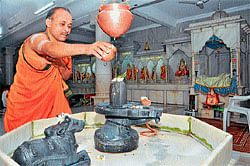Pak Shivalingam attracts crowd
Mahashivaratri is being celebrated all over the country on February 20. The Sindhi community in the city, just 260 families strong, also celebrates this festival. N Niranjan Nikam treads into the bylanes in the central business district to discover the Shivalingam brought from Pakistan and the Sindhi dharmashala where the reigning deity is Jhoolelal.

The old lady clad in white saree reading the Bhagavat scriptures in a bylane in Kamatageri behind Irwin Road lifts her head and warmly welcomes us with a smile.
“We came to Mysore in 1947 and settled down here,” says Kousalya and shows the Shiva lingam embedded in the hooded pedestal placed in a mantap with the idol of Shiva above and the Goddess Chamundeswari in the background.
Her son the Sindhi priest Mahesh Gopaldas Lalji, 62, clad in jubba and panche, who is popular among the small Sindhi community in the city, says that on Shivarthri day, the people from nearby places start coming from morning itself to offer pooja. “Anyone can come and offer the abhisheka themselves. They can even touch the lingam. We are all children of God. By doing the abhisheka you will be cleansing your own karmas,” he told City Herald, with a disarming smile.
The Shiva lingam made of stone is very cool as one touches it. The stone is sandal in colour and also has lovely grains which looks like teakwood. “We do not know how old it is. It was found in the river Ganges by our forefathers. When my father Gopaldas T Lalji, a priest, brought it to Mysore, one of his friends wanted to take it to his home. He agreed. But by afternoon, he had a vision and heard an angry voice which said, how dare you give it away to someone. Immediately, he brought it back,” said Mahesh.
“We also have another temple in the Sindhi Dharmshala where our deity Jhoolelal is worshipped. The uniqueness here is a South Indian priest from Gokarna does the pooja.
There are other gods like Rama, Radhakrishna, Ganapathi, Shiva, Balagopal, Balaji and also Shirdi Sai Baba,” said photographer D H Amardas as we pass through another bylane across Irwin Road and enter Vokkalegeri where the temple is located.
The priest Radhakrishna Bhat is performing rituals for a family. “The traditions of the Sindhis and the South Indians are more or less the same as both are Smarthas. But unlike in other temples, the Shivarathri ceremonies are performed here in the morning from 7 am to 1 pm and again from 6 pm to 9 pm. We do not keep awake the whole night,” said Bhat.
The highlight of the festival is preparing ‘Tandai.’ “The ingredients that go into making tandai include poppy seeds, jheera, black pepper, cardamom, almond, jaffar, kesar, sugar and raw milk. This is to keep the body cool. We use about 40 kg of sugar and 70 litres to 80 litres of milk. We keep churning it throughout the day and night as people keep coming and we keep offering them,” said the Sindhi priest Mahesh.
Another concoction that is added is Bhang. “Nobody should speak lightly of bhang and boast that he can drink it. In fact one or two of my tailor friends boasted and when I gave them tandai mixed with bhang, they did not know what hit them. One walked right up to Lalitha Mahal Palace and the other when he reached home, his head started spinning and he started acting funny. The next day they came and told me that they will never again touch bhang,” said Mahesh and added Amardas, “I had to be admitted to a hospital after drinking Tandai with bhang.”
“There is a legend associated with the Maha Shivarathri. Lord Vishnu and Lord Brahma once argued over who was the strongest and supreme of all. Lord Shiva challenged both of them and appeared as a flaming Linga and challenged them to measure the gigantic Linga. Neither Lord Vishnu nor Brahma could measure the Shivalinga. Then Lord Shiva came out of the Linga and declared himself the most powerful,” narrated Mahesh.
“We keep awake throughout the night. Apart from the morning poojas, the abhishekas are done at 9 pm, 12 midnight and 2.30 am. At 4 am, we all go to Chamundi hill to offer pooja to Chamundeshwari and come back and do the last pooja at 4.30 am,” said Mahesh.
On February 20 visit the home of Mahesh in Kamategeri and the Sindhi temple to celebrate Shivarathir and partake tandai.
Deccan Herald is on WhatsApp Channels| Join now for Breaking News & Editor's Picks